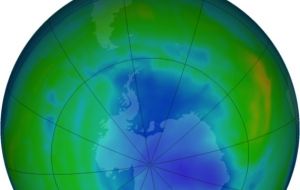MercoPress. South Atlantic News Agency
Ozone hole slightly smaller than average this year, according to NASA
 Nasa satellite infrared picture of the south pole and the ozone layer hole
Nasa satellite infrared picture of the south pole and the ozone layer hole The ozone hole that forms each year in the stratosphere over Antarctica was slightly smaller in 2013 than average in recent decades, according to NASA satellite data. The ozone hole is a seasonal phenomenon that starts to form during the Antarctic spring (August and September). The September-October 2013 average size of the hole was 8.1 million square miles (21 million square kilometers).
For comparison, the average size measured since the mid-1990s when the annual maximum size stopped growing is 8.7 million square miles (22.5 million square kilometers). However, the size of the hole in any particular year is not enough information for scientists to determine whether a healing of the hole has begun.
“There was a lot of Antarctic ozone depletion in 2013, but because of above average temperatures in the Antarctic lower stratosphere, the ozone hole was a bit below average compared to ozone holes observed since 1990,” said Paul Newman, an atmospheric scientist and ozone expert at NASA's Goddard Space Flight Center in Greenbelt, Md.
The ozone hole forms when the sun begins rising again after several months of winter darkness. Polar-circling winds keep cold air trapped above the continent, and sunlight-sparked reactions involving ice clouds and chlorine from manmade chemicals begin eating away at the ozone. Most years, the conditions for ozone depletion ease before early December when the seasonal hole closes.
Levels of most ozone-depleting chemicals in the atmosphere have gradually declined as the result of the 1987 Montreal Protocol, an international treaty to protect the ozone layer by phasing out production of ozone-depleting chemicals. As a result, the size of the hole has stabilized, with variation from year to year driven by changing meteorological conditions.
The single-day maximum area this year was reached on Sept. 16 when the maximum area reached 9.3 million square miles (24 million square kilometers), about equal to the size of North America. The largest single-day ozone hole since the mid-1990s was 11.5 million square miles (29.9 million square kilometers) on Sept. 9, 2000.
Science teams from NASA and the National Oceanic and Atmospheric Administration (NOAA) have been monitoring the ozone layer from the ground and with a variety of instruments on satellites and balloons since the 1970s. These ozone instruments capture different aspects of ozone depletion. The independent analyses ensure that the international community understands the trends in this critical part of Earth's atmosphere. The resulting views of the ozone hole have differences in the computation of the size of the ozone hole, its depth, and record dates.
NASA observations of the ozone hole during 2013 were produced from data supplied by the Ozone Monitoring Instrument on NASA's Aura satellite and the Ozone Monitoring and Profiler Suite instrument on the NASA-NOAA Suomi National Polar-orbiting Partnership satellite. Long-term satellite ozone-monitoring instruments have included the Total Ozone Mapping Spectrometer, the second generation Solar Backscatter Ultraviolet Instrument, the Stratospheric Aerosol and Gas Experiment series of instruments, and the Microwave Limb Sounder.




Top Comments
Disclaimer & comment rules-

-

-

Read all comments“The ozone hole is a seasonal phenomenon that starts to form during the Antarctic spring”
Oct 29th, 2013 - 08:19 am 0Exactly.
”As a result, (of the Montreal Protocol), the size of the hole has stabilized, with variation from year to year driven by changing meteorological conditions.“
This is a contradiction. First of all it is not a ”hole“. It is a thinning of the ozone layer. As with AGW they can give no measurement of the amount due to natural variation and they acknowledge the meteorological influence. It happens in Antarctica becuase of the extreme cold cold compared to the Arctic. There are some who would like to find a ”hole“ up there as well. The other issue is that there are also proven natural sources of CFC's which is always denied by the UN and their ”satellite” agencies such as the US EPA.
Its all right thinko. You can come out now
Oct 29th, 2013 - 05:46 pm 0OMG, GLOBAL WARMING..WE're all going to die..pay up those carbon taxes, because Al Gore, all those carbon nazis include the banksters claim: we're all going to die if we don't pay those darn carbon taxes..it's GLOBAL WARMING.
Oct 30th, 2013 - 04:32 am 0Yawn..
Commenting for this story is now closed.
If you have a Facebook account, become a fan and comment on our Facebook Page!